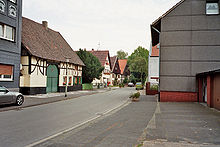Our Fritz / Crange

Our Fritz / Crange is a district in the Wanne district in the northwest of the city of Herne in North Rhine-Westphalia .
history
The district is connected to Haus Crange . The Cranger Church dates back to a chapel from 1449. The Cranger Kirmes goes back to a horse market from the 15th century. In 1484, Crange is referred to as freedom .
The community of Crange was incorporated into Wanne on October 28, 1906. On April 1, 1926, Wanne and Eickel were combined to form the independent city of Wanne-Eickel . On January 1, 1975 Wanne-Eickel was incorporated into the city of Herne. The Our Fritz colliery once gave the district special significance . It was in operation from 1874 to 1928.
Infrastructure
The Cranger Kirmes' fairground is now located on the disused shaft system of Shaft 5 on the Rhine-Herne Canal . With an average of four million visitors, it is the landmark of the district and the largest folk festival in North Rhine-Westphalia. Measured in terms of visitors per day, it even exceeds the Munich Oktoberfest . It took place for the 584th time in 2019.
In the district is the Kunsthaus Crange, a location of the youth art school Wanne-Eickel. The house offers dance and theater studios, painting and sculpture studios, goldsmiths and practice rooms as course rooms.
In addition, the concrete pump manufacturer Schwing is located in Crange and employs around 800 people there.
statistics
As of December 31, 2018, 6,986 inhabitants lived in the district of Unser Fritz / Crange, of which 4,553 were in the statistical district of Unser Fritz and 2,433 in the statistical district of Crange.
Our Fritz
Structure of the population in the statistical district Unser Fritz in 2018:
- Minor quota: 18.4% (Herner average: 15.9%)
- Old age quota: 16.9% (Herner average: 21.7%)
- Proportion of foreigners: 20.3% (Herner average: 17.9%)
- Unemployment rate: 8.5% (Herner average: 8.2%)
Crange
Structure of the population in the statistical district Crange in 2018:
- Minor quota: 17.1% (Herner average: 15.9%)
- Old age quota: 19.7% (Herner average: 21.7%)
- Proportion of foreigners: 24.0% (Herner average: 17.9%)
- Unemployment rate: 10.4% (Herner average: 8.2%)
Web links
Individual evidence
- ↑ a b Stephanie Reekers: The regional development of the districts and communities of Westphalia 1817-1967 . Aschendorff, Münster Westfalen 1977, ISBN 3-402-05875-8 , p. 224 and 291 .
- ^ Federal Statistical Office (ed.): Historical municipality directory for the Federal Republic of Germany. Name, border and key number changes in municipalities, counties and administrative districts from May 27, 1970 to December 31, 1982 . W. Kohlhammer, Stuttgart / Mainz 1983, ISBN 3-17-003263-1 , p. 329 .
- ↑ District profiles Herne - Statistical Districts 2018: Population in the statistical districts as a whole , City of Herne (PDF, 6.4 MB).
- ↑ a b District profiles Herne: Proportion of the population under 18 years of age , City of Herne (PDF, 6.4 MB).
- ↑ a b Herne district profiles: Proportion of the population aged 65 and over , City of Herne (PDF, 6.4 MB).
- ↑ a b District profiles of Herne: proportion of foreigners , City of Herne (PDF, 6.4 MB).
- ↑ a b District profiles of Herne: Share of unemployed in the working population (June 30, 2018) , City of Herne (PDF, 6.4 MB).
Coordinates: 51 ° 33 ' N , 7 ° 9' E
